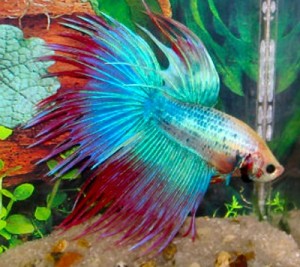 The Siamese fighting fish (Betta splendens), also known as pla-kad or trey krem (“Fighting Fish”) in Thailand, is a popular species of freshwater aquarium fish. The fish is a member of the gourami family (family Osphronemidae) of order Perciformes, but was formerly classified among the Anabantidae. Although there are nearly 50 other members of the Betta genus, B. splendens is the most popular species among aquarium hobbyists.
The Siamese fighting fish (Betta splendens), also known as pla-kad or trey krem (“Fighting Fish”) in Thailand, is a popular species of freshwater aquarium fish. The fish is a member of the gourami family (family Osphronemidae) of order Perciformes, but was formerly classified among the Anabantidae. Although there are nearly 50 other members of the Betta genus, B. splendens is the most popular species among aquarium hobbyists.
Siamese fighting fish usually grow to an overall length of about 5 cm , though some varieties reach 3-5 inches in length. Although known for their brilliant colors and large, flowing fins, the natural coloration of Siamese fighting fish is a dull green and brown, and the fins of wild specimens are relatively short. However, brilliantly colored and longer finned varieties (i.e. Veiltail; Delta; Superdelta; and Halfmoon) have been developed through selective breeding. This species lives approximately 2–5 years in captivity, generally between 2-3, rarely 4–5 years, fed with anabolics 5–7 years.
How to culture Siamese Fighting Fish
Biology
- Siamese fighting fish usually live near the water surface and feeds on insect larvae and small fishes.
- It could thrive even in poor quality water and limited space due to special lung-like labyrinth organ
- The male builds bubble nest below floating leaves where it places and takes care of the eggs and fry.
- Fighting fish breeds in pair and mating involves curling between male and female.
- It sexually matures in about six months, (about 2.5 inches).
- Female spawns every 3-4 weeks and produces 300 to 1,000 eggs per spawning.
- Male fighting fish are aggressive and must be kept individually.
Species:
- Half-moon
- Crown-tail
- Double tail
- Velitail
Sexual Characteristics
- Female: brighter colored body and well developed fins
- Male: less colored body, shorter fins, and bulging body with dark stripe
Breeding Culture Method
Materials needed:
- 5 gal aquarium
- Plastic container or small bottle
- Talisay or any floating leaf
- Scoop net, basin hose
Breeding Procedure
- Select a pair of ready-to-spawn breeders Male must be building bubble nest and female has bulging abdomen (ripe with eggs).
- Fill up aquarium with freshwater about 6 inches water depth. Put floating leaf.
- Put the breeders into the aquarium with the female placed inside the plastic container (to protect female while the male can see her). Male is aggressive at this point.
- Allow the male to build bubble nest below the floating leaf. When nest is finished, male is not aggressive anymore and will court the female by showing off its beautiful fins.
- Release the female from plastic container. The female will display dark diagonal bands on its body when it is ready to mate.
- Observe the mating behavior. The male curls its body towards the female with their genital pores close together.
- Eggs are released by female and fertilized by the male. The eggs fall down and male pick them up using its mouth and spits them back into the bubble nest.
- Remove the female after spawning. The male will take care of the eggs.
- After 2 days, eggs hatch into fry. The male will tend to the newly hatched fry. The tiny fry may fall down from the bubble nest but will be picked up by the male and spit them back to the nest.
- After another 2 days, the fry becomes free-swimming and search for food Remove the male breeder to prevent it from eating its young. Start feeding the fry.
Grow-out Culture
- Feed the fry with infusoria for the first 4 days. Infusoria are tiny microorganisms (25 to 300 um) that may be cultured by adding greenwater to boiled rice straw.
- On the 5th day until 2 weeks old, feed the fry with the newly hatched brine shrimp (Artemia) nauplii.
- When they are big enough to take larger food, feed the fry with mosquito larvae, tubifex or artificial feeds.
- At one month old, separate males from females. Reduce stocking density to 1-2 pc/gal or 50-100/ sq.m. or transfer to larger aquarium or tank.
- At 3 months old, males become aggressive. Separate the males individually in small jars or bottles.
- Water change must be done at least once a week at 20-30% rate.
- Rearing period is 4-6 months when they reach marketable size of 6 to 8 cm.
Disease Treatment
Use commercially available treatment chemicals.
- For white spot disease/”ich” – 5 drops anti-itch (malachite green)/gal
- For Anchor worm – 5 drops anti-anchor worm (trichlorfon)/gal
- For bacterial infection – 5 ppm oxytetracycline or tetracycline HCL
- For fungus – 5 drops methylene blue/gal
Procedure
- Add 1 teaspoon salt/gal water
- Permanent (24 hrs) bath
- Change water everyday
- For 5-7 consecutive days
Note: During treatment, provide vigorous aeration and avoid feeding.
For more information, contact:
Ma. Theresa M. Mutia
National Fisheries Biological Center (NFBC)
Butong, Taal, Batangas
Telefax: (043) 421-1465
Source: NFBC and Wikipedia.org; Photo: animal-world.com